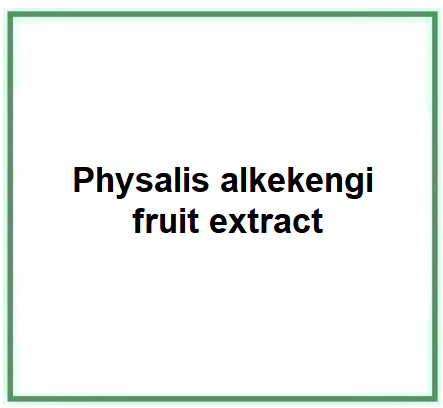Physalis alkekengi fruit extract, also known as Chinese lantern or bladder cherry extract, is derived from the fruits of the Physalis alkekengi (a plant belonging to the Solanaceae family) This extract is known for its antioxidant and soothing properties, and is commonly incorporated in skincare and cosmetic products for its ability to shield skin from free radical damage.

The name describes the structure of the ingredient
- "Physalis alkekengi" refers to the specific type of plant, commonly known as Chinese lantern or bladder cherry.
- "Fruit extract" indicates that it's an extract derived from the fruits of this plant.
Description of raw materials used in production
The primary raw material is the fruit of the Physalis alkekengi. Fruits are harvested when ripe.
Extraction process
- Fruit collection - Ripe fruits of Physalis alkekengi are collected.
- Extraction - The fruits are immersed in a solvent (like water, alcohol, or other solvents) to draw out the beneficial compounds.
- Filtration - The extract is then filtered to remove any solid particles.
- Evaporation - If used, the solvent is then evaporated off to yield a concentrated extract.
- Packaging - The Physalis alkekengi fruit extract is packaged into suitable containers for sale or for use in various products.
What it is for and where
Cosmetics
Skin conditioning agent. It is the mainstay of topical skin treatment as it has the function of restoring, increasing or improving skin tolerance to external factors, including melanocyte tolerance. The most important function of the conditioning agent is to prevent skin dehydration, but the subject is rather complex and involves emollients and humectants that can be added in the formulation.
CAS 90082-67-0
EC number 290-157-3
Commercial applications
Cosmetics and Skin Care
- Antioxidant Properties: Helps to combat free radicals and prevent oxidative stress, which contributes to skin aging.
- Soothing: Can aid in calming irritated or inflamed skin.
- Anti-aging: Some believe it can help improve skin elasticity and reduce the appearance of wrinkles due to its antioxidant content.
- Protective: Offers a degree of protection against environmental stressors.
Therapeutic Uses
- Traditionally, it has been used for its potential anti-inflammatory and diuretic properties.
- Might be used in formulations aimed at respiratory health, as it has been traditionally used for coughs and other respiratory issues.
Studies
The genus Physalis, besides alkekengi, Physalis alkekengi var franchetii, produces Physalis Peruviana and Physalis angulata L., both rich in vitamins, terpenoids and other antioxidants.
In particular, an anti-inflammatory seco-steroid, Phisalin E, has been isolated from Physalis angulata L. and is topically effective in treating skin inflammations (1).
Another bioactive steroid component, derived from Physalis alkekengi L. var franchetii, Phisalin A, has shown, in addition to anti-inflammatory activity, anti-tumor activity (2).
The role of intestinal flora improvement with extracts of Physalis alkekengi var franchetii, in vivo and in vitrum (3), has also been ascertained.
References_____________________________________________________________________
(1) Pinto N. B., Morais T. C., Carvalho K. M. B., et al. Topical anti-inflammatory potential of Physalin E from Physalis angulata on experimental dermatitis in mice. Phytomedicine. 2010;17(10):740–743. doi: 10.1016/j.phymed.2010.01.006
(2) Physalin A exerts anti-tumor activity in non-small cell lung cancer cell lines by suppressing JAK/STAT3 signaling. Zhu F, Dai C, Fu Y, Loo JF, Xia D, Gao SP, Ma Z, Chen Z. Oncotarget. 2016 Feb 23;7(8):9462-76. doi: 10.18632/oncotarget.7051.
(3) In vivo effects on the intestinal microflora of Physalis alkekengi var. francheti extracts. Li X, Zhang C, Li W, Wu D, Liu J, Tang L, Xin Y.
Fitoterapia. 2013 Jun;87:43-8. doi: 10.1016/j.fitote.2013.03.018.
In vitro effects on intestinal bacterium of physalins from Physalis alkekengi var. Francheti. Li X, Zhang C, Wu D, Tang L, Cao X, Xin Y.
Fitoterapia. 2012 Dec;83(8):1460-5. doi: 10.1016/j.fitote.2012.08.011.
![]() Physalis alkekengi fruit extract
Physalis alkekengi fruit extract 


